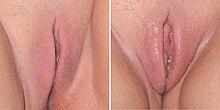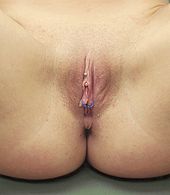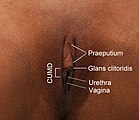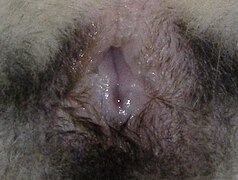Vulva
| Vulva | |
|---|---|
Superficial inguinal lymph nodes | |
| Identifiers | |
| Latin | vulva, pudendum muliebre, pudendum femininum |
| MeSH | D014844 |
| TA98 | A09.2.01.001 |
| TA2 | 3547 |
| FMA | 20462 |
| Anatomical terminology] | |
In
Blood supply to the vulva comes from the three pudendal arteries. The internal pudendal veins give drainage. Afferent lymph vessels carry lymph away from the vulva to the inguinal lymph nodes. The nerves that supply the vulva are the pudendal nerve, perineal nerve, ilioinguinal nerve and their branches. Blood and nerve supply to the vulva contribute to the stages of sexual arousal that are helpful in the reproduction process.
Following the development of the vulva, changes take place at birth,
Different cultures have held different views of the vulva. Some ancient religions and societies have worshipped the vulva and revered the female as a goddess. Major traditions in Hinduism continue this. In Western societies, there has been a largely negative attitude typified by the medical terminology of pudenda membra, meaning parts to be ashamed of. There has been an artistic reaction to this in various attempts to bring about a more positive and natural outlook, such as work from British, American, and Japanese artists. While the vagina is a separate part of the anatomy, it has often been used synonymously with vulva.[1]
Structure

In humans, the vulva is made up of the following:
Mons pubis
The mons pubis is the soft mound of fatty tissue at the front of the vulva, in the pubic region covering the pubic bone.[2] Mons pubis is Latin for "pubic mound" and is present in both sexes to act as a cushion during sexual intercourse, and is more pronounced in the female.[3] The variant term mons veneris ('mound of Venus') is used specifically for females.[4][3]
Labia
The
The grooves between the labia majora and labia minora are called the interlabial sulci, or interlabial folds.[9] The labia minora (smaller lips) are the two inner soft folds within the labia majora. They have more color than the labia majora[2] and contain numerous sebaceous glands.[10] They meet posteriorly at the frenulum of the labia minora, a fold of restrictive tissue. The labia minora meet again at the front to form the clitoral hood.[11]
Clitoris
Located at the anterior junction of the inner labia is the
Vestibule
The area between the labia minora where the
Muscles
Blood, lymph and nerve supply
The tissues of the vulva are highly
The
Variations

There is a great deal of variation in the appearance of the vulva.[11] Much of this variation lies in the significant differences in the size, shape, and color of the labia minora. Though called the smaller lips, they can often be of considerable size and may protrude outside the vulva or labia majora.[11][7] This variation has also been evidenced in a large display of 400 vulval casts called the Great Wall of Vagina created by Jamie McCartney to fill the lack of information of what a normal vulva looks like. The casts taken from a large and varied group of women showed clearly that there is much variation.[33][11]
Researchers from the Elizabeth Garret Anderson Hospital, London, measured multiple genital dimensions of 50 women between the ages of 18 and 50, with a mean age of 35.6:[34]
| Measurements | Mean [standard deviation] | |
|---|---|---|
| Clitoral length (mm) | 5.0 – 35.0 | 19.1 [8.7] |
| Clitoral glans width (mm) | 3.0 – 10.0 | 5.5 [1.7] |
| Clitoris to urethra (mm) | 16.0 – 45.0 | 28.5 [7.1] |
| Labia majora length (cm) | 7.0 – 12.0 | 9.3 [1.3] |
| Labia minora length (mm) | 20 – 100 | 60.6 [17.2] |
| Labia minora width (mm) | 7.0 – 50.0 | 21.8 [9.4] |
| Perineum length (mm) | 15.0 – 55.0 | 31.3 [8.5] |
| Vaginal length (cm) | 6.5 – 12.5 | 9.6 [1.5] |
| Tanner stage (n) | IV | 4.0 (8%) |
| V | 46 (92%) | |
| Color of the genital area compared to the surrounding skin (n) | Same color | 9 (18%) |
| Darker color | 41 (82%) | |
| Rugosity of the labia (n) | Smooth (unwrinkled) | 14 (28%) |
| Moderately wrinkled | 34 (68%) | |
| Markedly wrinkled | 2 (4%) |
Development
Prenatal development


In week three of
At the same time, a pair of swellings on either side of the urethral folds known as the genital swellings develop into the
The uterovaginal canal or genital canal, forms in the third month of the development of the urogenital system. The lower part of the canal is blocked off by a plate of tissue, the vaginal plate. This tissue develops and lengthens during the third to fifth months and the lower part of the vaginal canal is formed by a process of desquamation or cell shedding. The end of the vaginal canal is blocked off by an endodermal membrane, which separates the opening from the vestibule. In the fifth month, the membrane degenerates but leaves a remnant called the hymen.[36]
Childhood
The newborn's vulva may be swollen or enlarged as a result of having been exposed, via the placenta, to her mother's increased levels of hormones.[38] The labia majora are closed.[39] These changes disappear over the first few months.[38] During childhood before puberty, the lack of estrogen can cause the labia to become sticky and to ultimately join firmly together. This condition is known as labial fusion and is rarely found after puberty when estrogen production has increased.[40]
Puberty
Puberty is the onset of the ability to reproduce, and takes place over two to three years, producing a number of changes.[41][42] The structures of the vulva become proportionately larger and may become more pronounced.[43] Pubarche, the first appearance of pubic hair develops, firstly on the labia majora, and later spreads to the mons pubis, and sometimes to the inner thighs and perineum. Pubic hair is much coarser than other body hair, and is considered a secondary sex characteristic.[44] Pubarche can occur independently of puberty. Premature pubarche may sometimes indicate a later metabolic-endocrine disorder seen at adolescence. The disorder sometimes known as a polyendocrine disorder is marked by elevated levels of androgen, insulin, and lipids, and may originate in the fetus. Instead of being seen as a normal variant it is proposed that premature pubarche may be seen as a marker for these later endocrine disorders.[45]
Pregnancy
In pregnancy, the vulva and vagina take on a bluish coloring due to venous congestion. This appears between the eighth and twelfth week and continues to darken as the pregnancy continues.[37] Estrogen is produced in large quantities during pregnancy and this causes the vulva to become enlarged. The vaginal opening and the vagina are also enlarged.[52] After childbirth, a vaginal discharge known as lochia is produced and continues for about ten days.[52]
Menopause
During menopause, hormone levels decrease, which causes changes in the vulva known as vulvovaginal atrophy.[53] The decreased estrogen affects the mons, the labia, and the vaginal opening and can cause pale, itchy, and sore skin.[53] Other visible changes are a thinning of the pubic hair, a loss of fat from the labia majora, a thinning of the labia minora, and a narrowing of the vaginal opening. This condition has been renamed by some bodies as the genitourinary syndrome of menopause as a more comprehensive term.[53]
Function and physiology
The vulva has a major role to play in the reproductive system. It provides entry to, and protection for the uterus, and the right conditions in terms of warmth and moisture that aids in its sexual and reproductive functions. The external organs of the vulva are richly innervated and provide pleasure when properly stimulated. The mons pubis provides cushioning against the pubic bone during intercourse.[11]
A number of different secretions are associated with the vulva, including
Sexual stimulation

The clitoris and the labia minora are both erogenous areas of the vulva. Local stimulation can involve the clitoris, vagina and other perineal regions. The clitoris (especially the glans) is the human female's most sensitive erogenous zone and generally the primary anatomical source of human female sexual pleasure.[55] Sexual stimulation of the clitoris (by a number of means) can result in widespread sexual arousal and, if maintained, can result in orgasm. Stimulation to vulvar orgasm is optimally achieved by a massaging sensation,[43] such as oral sex (cunnilingus) and fingering.
Sexual arousal results in a number of physical changes in the vulva. During arousal,
Distance between vagina and clitoral glans
The distance between the
-
Glans clitoridis with small distance to the opening
-
Contact of the clitoral glans with the penis with small CUMD
-
Glans clitoridis with medium distance to the opening
-
Lack of contact of the clitoral glans with the penis
-
Classification of the 200 women into CUMD categories
-
Selection of women studied and interviewed
A study by Carney Landis and colleagues in 1940 includes statements to this effect: "On the physical side orgasm capacity is related to clitoris-meatus distance". (Landis et al. 1940).[60][61]
In 2011, Kim Wallen[62] and Elisabeth Lloyd reviewed Bonaparte's research and confirmed an inverse correlation between CUMD and orgasm through intercourse.[63][64][65][66] In methods taught since the 1970s by Betty Dodson, the sexual arousal of the woman during vaginal intercourse is to be ensured by the woman independently stimulating her clitoris continuously with her hands or possibly with a vibrator.[67][68] According to Kim Wallen, the CUMD says nothing about a happy sex life, rather that a large gap gives couples an opportunity "to be a bit more inventive in how they have sex".[64]
Clinical significance
Irritation
Irritation and
Sexually transmitted infections


Vulvar organs and tissues can become affected by different
Cancer
Surgery (with or without removal of regional lymph nodes) is usually the primary treatment modality. Typically, a wide-local excision is performed, in which the tumor is excised including a safety-margin of healthy tissue to ensure its entire removal, which is confirmed by a pathologist.[90] In more advanced disease, a (partial) vulvectomy may need to be performed in order to remove some or all of the vulva.[94] Advanced-stage melanomas can be treated with checkpoint inhibitors.[95]
Other
Vulvodynia is chronic pain in the vulvar region. There is no single identifiable cause.[97] A subtype of this is vulvar vestibulitis but since this is not thought to be an inflammatory condition it is more usually referred to as vestibulodynia.[98] Vulvar vestibulitis usually affects pre-menopausal women.[98]
Pudendal nerve entrapment can cause sharp pain or numbness in the vulva. This condition can be caused by activities such as cycling, giving birth, or prolonged sitting.
A number of
Childbirth
The vulvar region is at risk for trauma during childbirth.[104] During childbirth, the vagina and vulva must stretch to accommodate the baby's head (approximately 9.5 cm (3.7 in)). This can result in tears known as perineal tears in the vaginal opening, and other structures within the perineum.[105] An episiotomy (a pre-emptive surgical cutting of the perineum) is sometimes performed to facilitate delivery and limit tearing. A tear takes longer to heal than an incision.[106] Tears and incisions may be repaired using sutures that may be layered.[107][37] Among the methods of hair removal evaluated for pre-surgeries, pubic hair shaving known as prepping, was seen to increase the risk of surgical site infections.[108][106] No advantages have been demonstrated in the routine shaving of pubic hair prior to childbirth.[109]
Surgery
The use of cosmetic surgeries has been criticized by clinicians.[114][115] The American College of Obstetricians and Gynecologists recommends that women be informed of the risks of these surgeries. They refer to the lack of data relevant to their safety and effectiveness and to the potential associated risks such as infection, altered sensation, dyspareunia, adhesions, and scarring.[116] There is also a percentage of people seeking cosmetic surgery who may be suffering from body dysmorphic disorder and surgery in these cases can be counterproductive.[117]
Society and culture
Altering the female genitalia
In some
In some cultures, including modern Western culture, women have shaved or otherwise


Several forms of genital piercings can be made in the vulva, and include the Christina piercing, the Nefertiti piercing, the fourchette piercing, and labia piercings. Piercings are usually performed for aesthetic purposes, but some forms like the clitoral hood piercing might also enhance pleasure during sex. Though they are common in traditional cultures, intimate piercings are a fairly recent trend in Western society.[130][131][132] Other forms of permanent modifications of the vulva for cultural, decorative or aesthetic reasons are genital tattoos or scarification (so-called "hanabira").
Female genital surgery includes
With the growing popularity of female cosmetic genital surgeries, the practice increasingly draws criticism from an opposition movement of
Female genital mutilation
The most prevalent form of non-consensual genital alteration is that of female genital mutilation. This mostly involves the partial or complete removal of the vulva.[136] Female genital mutilation is carried out in thirty countries in Africa and Asia with more than 200 million girls being affected, and some women (as of 2018).[136] Nearly all of the procedures are carried out on young girls. The practices are also carried out globally among migrants from these areas. Female genital mutilation is claimed to be mostly carried out for cultural traditional reasons.[136] According to the research conducted under In the Name of Tradition, FGM/C is more common in Sunni countries and less common in Shia societies.[137][138][139][140]
FGM/C can have harmful effects on their physical and mental health. Various official and unofficial research reports also confirm these complications. In its various reports, the World Health Organization has considered FGM/C as an action that endangers women's health in various ways. This organization stated in a report published in January 2023 that FGM/C has no health benefits, and it harms girls and women in many ways. It involves removing and damaging healthy and normal female genital tissue, and it interferes with the natural functions of girls' and women's bodies. Although all forms of FGM/C are associated with increased risk of health complications, the risk is greater with more severe forms of FGM/C.[141][142][143]
The American National Library of Medicine also stated in an article in 2018 that the consequences of FGM/C have both physiological and psychological complications, including short- and long-term complications. The method in which the procedure is performed may determine the extent of the short-term complications. If the process was completed using unsterile equipment, no antiseptics, and no antibiotics, the victim may have increased risk of complications. Primary infections include staphylococcus infections, urinary tract infections, excessive and uncontrollable pain, and hemorrhaging. Infections such as human immunodeficiency virus (
Etymology

The word vulva is Latin for "womb". It derives from the 1540s in referring to the womb and female sexual organs, from the earlier volvere meaning to turn, roll or revolve, with further derivatives such as used in volvox, and volvulus (twisted bowel).[147][148] The naming of the female (and male) genitals as pudenda membra, meaning parts to be ashamed of, dates from the mid-17th century.[149] The naming influenced the general perception of the vulva and this is shown in depicted gynaecological procedures. The examiner shown in the Obstetrical examination dated 1822, is adopting the compromise procedure where the woman's genitals cannot be seen.[150][151]
Terminology
In 2021, a study in the UK showed that few are able to label the structure of the vulva correctly.[152][153][154]
There are many
Religion and art
Some cultures have long celebrated and even worshipped the vulva. During the

Some major

Japanese sculptor and manga artist Megumi Igarashi has focused much of her work on painting and modelling vulvas and vulva-themed works. She has used molds to create dioramas – three-dimensional models of her vulva with the hope of demystifying the female genitals.[179]
An art installation called The Dinner Party by feminist artist, Judy Chicago, portrays a symbolic history of famous women. The dinner plates each depict an elaborate vulval form and they are arranged in a triangular vulva shape.[180] Another installation was made by British artist Jamie McCartney who used the casts of four hundred vulvas to create The Great Wall of Vagina in 2011. The casts are life-size. Explanations written by the project's sexual health adviser accompany these. The purpose of the artist was to "address some of the stigmas and misconceptions that are commonplace".[181][33]
Other animals
-
Vulva of an Asian elephant
-
Vulva of a dog (German Shepherd)
-
Vulva of a horse
-
Vulva of a cat
As a rule, only the external female genitals of
For comparison, birds, reptiles, amphibians, some aquatic animals, and the monotremes have a cloaca. An organ system like a vulva does not exist.
The urinary and vaginal openings of a typical mammalian vulva are separated from the
All female mammals have a clitoris.[184] Inside the clitoris of many non-human placentals is the baubellum, a small bone that possibly has origins in copulation. In horses and dogs, the clitoris is contained in clitoral fossa, which is a small pouch of tissue.[185][186] Genital papilla is a fleshy flab of tissue on the vulvas of some mammals. The vulva of a spotted hyena has a large clitoris known as a pseudo-penis as well as fused labia (pseudo-scrotum). This can make it difficult to correctly sex the species.
Non-human primates

Throughout the menstrual cycle, some female primates' vulvar and anal regions will swell (sexual swelling) to attract a male, though the fundamental reason for this function is up for debate.[187]
The structure of the vulva in primates (including humans) differs slightly among other mammals. A significant characteristic is the presence of the labia majora (although a lot of primate species possess this feature until full maturity). Carnivorans and ungulates for example only have one pair of small labia called the labia vulvae, similar to that of the primate labia minora.[188][189][190][191] Because of this, the pudendal cleft refers to the slit between the labia vulvae in non-primates.[191]
Another difference is that the vulval vestibule and clitoral prepuce in other mammals is also called the urogenital sinus (the name of a part in the mammalian embryo)[192] and clitoral sheath respectively.[193][194]
Additional images
-
Attic red-figure lid depicting three vulvae and a winged penis
See also
Penis – external male reproductive organ
References
![]() This article incorporates text in the public domain from page 1264 of the 20th edition of Gray's Anatomy (1918)
This article incorporates text in the public domain from page 1264 of the 20th edition of Gray's Anatomy (1918)
- ^ a b "What are the parts of the female sexual anatomy?". Planned Parenthood. Archived from the original on 20 November 2018. Retrieved 30 March 2018.
- ^ a b "Anatomy and Physiology of the Female Reproductive System · Anatomy and Physiology". Phil Schatz.com. Archived from the original on 24 May 2020. Retrieved 14 March 2018.
- ^ ISBN 978-0195392883. Archived from the originalon 5 November 2019. Retrieved 18 September 2019.
The rounded mass of fatty tissue lying over the joint of the pubic bones, in women typically more prominent and also called the mons Veneris.
- OCLC 1045367748.
- ^ ISBN 9780198568780.
- ^ ISBN 9780470233474.
- ^ PMID 23650202.
- ISBN 9781449630911. Archivedfrom the original on 22 January 2022. Retrieved 18 March 2018.
- ISBN 9781444316698. Archivedfrom the original on 22 January 2022. Retrieved 14 March 2018.
- ISBN 978-0-443-06850-8.
- ^ ISBN 978-0130149947.
- ISBN 978-3-66243-680-6.
- ISBN 9783662436806. Archivedfrom the original on 22 January 2022. Retrieved 18 March 2018.
- S2CID 26109805.
- ISBN 9781451132182.
- PMID 26195958.
- PMID 18793993.
- ISBN 978-0-7020-3120-5.
- S2CID 14737481.
- ISBN 9781416062578.
- ISBN 9781416062578.
- ^ "Superficial Inguinal Lymph Nodes — Medical Definition". www.medilexicon.com. Archived from the original on 12 May 2016. Retrieved 25 March 2018.
- ^ ISBN 9781416062578.
- ^ PMID 23809460.
- ISBN 9781416062578.
- PMID 15201770.
- ^ "Clinical Case - Perineum & External Genitalia". The University of Michigan. 27 February 2009. Archived from the original on 27 February 2009. Retrieved 26 March 2018.
- ^ ISBN 9780071716727.
- ISBN 978-0-7817-5309-8.
- ^ "Innie vs. outie vagina: What are the differences? Learn more here". www.medicalnewstoday.com. 18 February 2021. Archived from the original on 16 December 2021. Retrieved 20 December 2021.
- ^ "Do You Have An Outie Vagina Or An Innie Vagina? Here's How To Tell". Women's Health. 17 April 2019. Archived from the original on 4 March 2022. Retrieved 20 December 2021.
- OCLC 1240584800. Archivedfrom the original on 4 March 2022. Retrieved 20 December 2021.
- ^ a b "'The Great Wall Of Vagina' Is, Well, A Great Wall Of Vaginas (NSFW)". Huffington Post. 8 January 2014. Archived from the original on 8 October 2017. Retrieved 18 March 2018.
- ^ ISBN 9780781790697.
- ^ ISBN 978-0443065835.
- ^ ISBN 978-0060466695.
- ^ a b "Hormonal effects in newborns: MedlinePlus Medical Encyclopedia". MedlinePlus. Archived from the original on 28 July 2018. Retrieved 18 March 2018.
- S2CID 30716752.
- ^ a b "NHS Direct Wales - Encyclopaedia : Labial fusion". NHS Direct Wales. Archived from the original on 27 September 2011. Retrieved 26 March 2018.
- ISBN 978-0805318005.
- PMID 5785179.
- ^ ISBN 9781416045748.
- ^ "Secondary Characteristics". hu-berlin.de. Archived from the original on 27 September 2011.
- PMID 11117666.
- ^ "Sweating and body odor: Causes". Mayo Clinic. Archived from the original on 15 April 2016. Retrieved 16 April 2016.
- ^ a b c "Pheromones Sex attraction" (PDF). Archived from the original (PDF) on 26 July 2019. Retrieved 1 March 2018.
- S2CID 17818072.
- ISBN 9780198568780.
- DermNet NZ. Archivedfrom the original on 20 September 2018. Retrieved 26 March 2018.
- ISBN 978-0781744935.
- ^ ISBN 9781416045748.
- ^ PMID 29202940.
- ^ "Definition of SMEGMA". Merriam-Webster. Archived from the original on 19 May 2020. Retrieved 20 April 2016.
- ISBN 978-0-7637-7660-2. Archivedfrom the original on 13 June 2013. Retrieved 1 January 2021.
- ISBN 978-0697056757.
- PMID 10693116.
- ^ A. E. Narjani: "Considérations sur les causes anatomique de la frigidité chez la femme". In: Journal Médicale de Bruxelles, single print from vol. 42, Imprimerie Médicale et Scientifique (q.v.), Brussels, 27 April 1924, page 1-11.
- ^ Lisa Appignanesi, John Forrester: The Women of Sigmund Freud. Munich 1996, page 451-471.
- ^ Carney Landis, Agnes T. Landis, M. Marjorie Bolles et al.: Sex in development: a study of the growth and development of the emotional and sexual aspects of personality together with physiological, anatomical, and medical information on a group of 153 normal women and 142 female psychiatric patients Archived 9 October 2021 at the Wayback Machine. P. B. Hoeber, New York, London 1940; Neuauflage: McGrath Publications, Maryland 1970.
- ^ W. H. Staff: 'The Location Of Your Clit Might Determine How Easily You Orgasm Archived 9 October 2021 at the Wayback Machine'. In: Women's Health, October 1, 2019.
- ^ "Kim Wallen". Archived from the original on 9 October 2021. Retrieved 8 November 2021.
- ^ a b Nuzzo, Regina (11 February 2008). "Female orgasms and a 'rule of thumb'". Los Angeles Times. Archived from the original on 30 October 2021.
- ^ Dennis Thompson: 'Anatomy May Be Key to Female Orgasm Archived 9 October 2021 at the Wayback Machine'. In: Healthy Day, 21. April 2016.
- ^ W. H. Staff: 'The Location Of Your Clit Might Determine How Easily You Orgasm Archived 9 October 2021 at the Wayback Machine'. In: Women's Health, 1. Oktober 2019.
- ^ Betty Dodson: Sex for One: The Joy of Selfloving. Crown Trade Paperbacks, New York 1996. ISBN 0 517 88607 3.
- ^ Betty Dodson: Orgasms for Two - the joy of partnersex. Harmony July 1, 2003.
- ^ "Thrush in men and women". NHS UK. 9 January 2018. Archived from the original on 25 September 2018. Retrieved 25 March 2018.
- (PDF) from the original on 18 May 2015. Retrieved 26 March 2016.
- S2CID 3500357.
- ^ "Vaginitis – Symptoms and causes". Mayo Clinic. Archived from the original on 7 July 2006. Retrieved 18 March 2018.
- ^ "Pubic Hair Removal – Shaving". Palo Alto Medical Foundation. Archived from the original on 7 September 2012. Retrieved 13 November 2011.
- S2CID 45115301.
- S2CID 37730720.
- ^ a b "CDC - What Are the Symptoms of Vaginal and Vulvar Cancers?". Centers for Disease Control and Prevention. Archived from the original on 27 July 2019. Retrieved 18 March 2018.
- ^ PMID 17342668.
- ^ a b "Sexually transmitted infections (STIs) Fact sheet N°110". WHO. November 2013. Archived from the original on 25 November 2014. Retrieved 30 November 2014.
- ^ "safe sex | Definition of safe sex in English by Oxford Dictionaries". Oxford Dictionaries. Archived from the original on 25 September 2018. Retrieved 18 March 2018.
- ^ "Syphilis - CDC Fact Sheet (Detailed)". Centers for Disease Control and Prevention. 2 November 2015. Archived from the original on 30 July 2018. Retrieved 3 February 2016.
- ^ "STD Facts - Gonorrhea". Centers for Disease Control and Prevention. 11 December 2017. Archived from the original on 16 December 2016. Retrieved 11 December 2017.
- ISBN 9780323400374. Archivedfrom the original on 3 August 2020. Retrieved 19 October 2020.
- ^ "Human papillomavirus (HPV) and cervical cancer". WHO. June 2016. Archived from the original on 5 August 2016.
- ^ "Genital Herpes – CDC Fact Sheet". Centers for Disease Control and Prevention. 9 February 2017. Archived from the original on 31 December 2014. Retrieved 20 December 2017.
- PMID 25151473.
- PMID 23977728.
- ^ "Risk Factors - Molluscum Contagiosum". Centers for Disease Control and Prevention. Archived from the original on 10 June 2017. Retrieved 24 March 2016.
- PMID 28993385.
- ^ "STD Facts - Trichomoniasis". Centers for Disease Control and Prevention. Archived from the original on 19 February 2013. Retrieved 5 October 2017.
- ^ PMID 31829526.
- ^ "About vulval cancer". Cancer Research UK. Archived from the original on 14 April 2016. Retrieved 6 April 2016.
- ^ a b "Types of vulval cancer". Cancer Research UK. Archived from the original on 31 December 2017. Retrieved 19 March 2018.
- PMID 31784896.
- PMID 22244661.
- PMID 33252450.
- DermNet NZ. Archivedfrom the original on 2 October 2018. Retrieved 26 March 2018.
- PMID 21542444.
- ^ PMID 9084950.
- PMID 24252167.
- PMID 28778643.
- ^ PMID 16488526.
- PMID 19150287.
- PMID 23668525.
- (PDF) from the original on 10 August 2017. Retrieved 28 December 2018.
- ISBN 978-0-7295-3736-0.
- ^ ISBN 978-0130149947.
- ^ "Perineal Trauma: Assessment and Repair". the women's. Archived from the original on 1 October 2011. Retrieved 1 October 2011.
- PMID 26320612.
- PMID 25398160.
- ^ "genitoplasty". TheFreeDictionary. Archived from the original on 3 October 2018. Retrieved 18 March 2018.
- PMID 28846226.
- ^ Munro, Donald. "Trans Media Watch". Trans Media Watch. Archived from the original on 18 December 2019. Retrieved 18 March 2018.
- ISBN 9780323510042. Archivedfrom the original on 6 August 2020. Retrieved 7 February 2017.
- ^ Bourke, Emily (12 November 2009). "Designer vagina craze worries doctors". Australian Broadcasting Corporation. Archived from the original on 12 November 2012. Retrieved 5 March 2016.
- PMID 17525451.
- ^ a b American College of Obstetricians and Gynecologists (2007). "Vaginal "Rejuvenation" and Cosmetic Vaginal Procedures" (PDF). New View Campaign: 2. Archived from the original (PDF) on 30 December 2008.
- PMID 21831574.
- ^ a b "Rwandan Women View The Elongation Of Their Labia As Positive". Medical News Today. Archived from the original on 17 June 2018. Retrieved 27 March 2018.
- ^ "Jan Nederveen Pieterse, Wit over zwart · dbnl". DBNL (in Dutch). Archived from the original on 21 May 2019. Retrieved 28 March 2018.
- S2CID 8307959.
- PMID 27921861.
- ^ "Health and beauty: vaginal practices: Indonesia (Yogyakarta), Mozambique (Tete), South Africa (KwaZulu-Natal), and Thailand (Chonburi)" (PDF). World Health Organization. Archived (PDF) from the original on 26 October 2013. Retrieved 27 March 2018.
- ^ "Labia stretching: Why some British girls are told to do it". BBC News. 7 April 2017. Archived from the original on 16 April 2019. Retrieved 24 April 2018.
- ^ Akumu, Patience (16 June 2010). "Labia elongation: Invaluable culture or dangerous practice?". The Observer – Uganda. Archived from the original on 22 September 2018. Retrieved 24 April 2018.
- ISBN 978-3-8258-6762-1.
- (PDF) from the original on 14 March 2020. Retrieved 2 September 2019.
- ISBN 9781420005318. Archivedfrom the original on 4 March 2022. Retrieved 27 March 2018.
- ^ ISBN 1-4018-1555-3
- ISBN 978-1-932-09921-8.
- ^ "Can selfish lovers ever give as good as they get? Plus, the perks of piercings and how to get her to hurry up already". MSNBC. 4 December 2007. Archived from the original on 4 September 2018. Retrieved 13 November 2011.
- from the original on 2 August 2020. Retrieved 13 November 2011.
- ^ "VCH Piercings, by Elayne Angel, Seite 16-17, The Official Newsletter of The Association of Professional Piercers" (PDF). Archived from the original (PDF) on 22 November 2011. Retrieved 13 November 2011.
- S2CID 51613481.
- ^ Clark-Flory, Tracy (17 February 2013). "The "labia pride" movement: Rebelling against the porn aesthetic, women are taking to the Internet to sing the praises of "endowed" women". Salon.com. Archived from the original on 30 September 2018. Retrieved 14 March 2013.
- ^ Sourdès, Lucile (21 February 2013). "Révolution vulvienne: Contre l'image de la vulve parfaite, elles se rebellent sur Internet". Rue89. Archived from the original on 12 October 2017. Retrieved 14 March 2013.
- ^ a b c "Female genital mutilation". World Health Organization. 2016. Archived from the original on 21 August 2015. Retrieved 21 February 2018.
- ^ Ahmady, Kameel Et al 2015: In the Name of Tradition (A Comprehensive Research Study on Female Genital Mutilation / Cutting (FGM/C) in Iran), Un-Cut/Voices Press, Germany.
- ISSN 0261-3077. Retrieved 18 January 2024.
- ^ "Anthropologist reveals FGM practised in western, southern Iran. Reuters". Reuters.
- S2CID 214163821.
- ^ "Female genital mutilation". www.who.int. Retrieved 18 January 2024.
- ^ "Female Genital Mutilation". WHO | Regional Office for Africa. 17 January 2024. Retrieved 18 January 2024.
- ^ "Female Genital Mutilation Hurts Women and Economies". www.who.int. Retrieved 18 January 2024.
- PMID 30116269.
- ^ "Figure 3 | Female Genital Mutilation/Cutting: Innovative Training Approach for Nurse-Midwives in High Prevalent Settings". www.hindawi.com. Retrieved 18 January 2024.
- S2CID 13662969.
- ^ "Vulva | Define Vulva at Dictionary.com". Archived from the original on 23 March 2018. Retrieved 23 March 2018.
- ^ a b c d "vulva". Online Etymology Dictionary. Archived from the original on 7 February 2017. Retrieved 1 July 2007.
- ISBN 9780199640942. Archivedfrom the original on 4 March 2022. Retrieved 10 May 2012.
- ^ "Women's problems in early 1800s". Bronwen Evans. 15 April 2016. Archived from the original on 21 May 2018. Retrieved 30 March 2018.
- PMID 22399872.
- from the original on 4 March 2022. Retrieved 23 October 2021.
- ^ Geddes, Linda (30 May 2021). "Most Britons cannot name all parts of the vulva, survey reveals". The Guardian. Archived from the original on 26 October 2021. Retrieved 23 October 2021.
- ^ Morgan, Eleanor (16 October 2021). "Viva la vulva: why we need to talk about women's genitalia". The Guardian. Archived from the original on 23 October 2021. Retrieved 23 October 2021.
- ^ For slang terms for the vulva, see WikiSaurus:female genitalia — the WikiSaurus list of synonyms and slang words for female genitalia in many languages.
- ISBN 978-0-19-211651-2.
Pet form of Frances, very popular in the 18th and 19th centuries, but now much rarer
- ISBN 978-1-84627-452-7. Archivedfrom the original on 8 May 2016. Retrieved 22 February 2017.
- ISBN 978-0-313-39934-3. Archivedfrom the original on 17 May 2016. Retrieved 12 May 2016.
While pussy as a euphemism for vagina is very common in popular parlance, Mrs Slocombe was actually talking about her pet cat. In this context, the use of pussy works as a double entendre rather than as a euphemism.
- ^ Jeffries, Stuart (2008). Mrs Slocombe's Pussy: Growing Up in Front of the Telly. Flamingo.
Mrs Slocombe's pussy changed all that.[...]It was funny, surely, because it dissolved that secret source of female power into a double entendre.
- ^ "pussy | Definition of pussy in English by Oxford Dictionaries". Oxford Dictionaries | English. Archived from the original on 3 October 2018. Retrieved 14 February 2018.
- ^ "fanny | Definition of fanny in English by Oxford Dictionaries". Oxford Dictionaries | English. Archived from the original on 3 October 2018. Retrieved 14 February 2018.
- ISBN 9780520082311. Archivedfrom the original on 4 March 2022. Retrieved 19 October 2020.
- ^ "vagina | Synonyms of vagina by Oxford Dictionaries Thesaurus". Oxford Dictionaries | %{language. Archived from the original on 31 March 2018.}
- ISBN 978-0-02-861207-2.
- ^ ISBN 978-1-134-92074-7. Archivedfrom the original on 14 April 2021. Retrieved 3 January 2018.
- ISBN 978-3-16-154278-7. Archivedfrom the original on 3 September 2021. Retrieved 19 October 2020.
- ISBN 978-0-8146-5734-8. Archivedfrom the original on 3 September 2021. Retrieved 19 October 2020.
- ISBN 978-0-7141-1705-8. Archivedfrom the original on 20 November 2020. Retrieved 19 October 2020.
- ^ "Yoni". Merriam-Webster. Archived from the original on 18 October 2018. Retrieved 30 March 2016.
- ^ ISBN 9780198610250. Archivedfrom the original on 18 October 2018. Retrieved 27 March 2018.
- ISBN 9780521438780. Retrieved 27 March 2018.
devi.
- ^ "Mudra Photo Gallery". Archived from the original on 18 October 2018. Retrieved 18 March 2018.
- ISBN 9780415345521. Archivedfrom the original on 2 November 2020. Retrieved 24 February 2018.
- ISBN 978-87-423-0182-1.
- ISBN 9781620555958. Archivedfrom the original on 18 October 2018. Retrieved 9 January 2017.
- ^ "Musée d'Orsay: Gustave Courbet The Origin of the World". Musée d'Orsay. Archived from the original on 19 March 2016. Retrieved 27 March 2018.
- ^ Dickey, Christopher (1 January 2019). "The Muslim Playboy Behind Paris' Most Scandalous Painting". The Daily Beast. Archived from the original on 19 July 2020. Retrieved 27 March 2020.
- from the original on 4 April 2020. Retrieved 27 March 2020.
- ^ McCurry, Justin (15 July 2014). "Vagina selfie for 3D printers lands Japanese artist in trouble". The Guardian. Archived from the original on 4 March 2018. Retrieved 4 March 2018.
- ISBN 978-1-85894-370-1.
- ISBN 978-0956878502.
- ^ E. Szabó, B. Hargitai, A. Regos u. a.: "TRA-1/GLI controls the expression of the Hox gene lin-39 during C. elegans vulval development". In: Developmental Biology. Band 330, Nr. 2, 2009, S. 339–348. PMID 19361495.
- ISBN 978-0-71671-811-6. Retrieved 3 December 2023.
- ISBN 978-1-4039-8602-3. Archivedfrom the original on 15 June 2013. Retrieved 27 October 2015.
- ISBN 978-1-41603-139-0.
- ISBN 978-3-89993-003-0.
- ISBN 9780080582740.
- ISBN 978-0-32313-804-8. Retrieved 10 November 2023.
- ISBN 978-3-64271-074-2. Retrieved 19 November 2023.
- ISBN 978-1-40814-955-3. Retrieved 15 December 2023.
- ^ ISBN 978-0-70204-744-2.
- ISBN 978-1-42143-733-0.
- ISBN 978-1-91045-577-7.
- ISBN 978-0-58539-937-9.
External links
 Media related to Vulva symbols at Wikimedia Commons
Media related to Vulva symbols at Wikimedia Commons- 'V' is for vulva, not just vagina by Harriet Lerner discussing common misuse of the word "vagina"
- Vulvar hygiene and Urinary Tract Infections by Heather Corinna (illustrations; no explicit photos)














